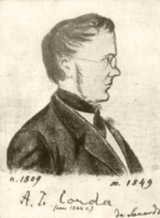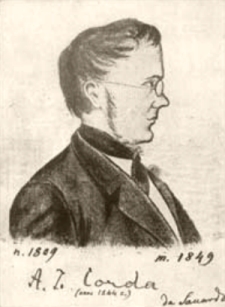
August Carl Joseph Corda
Encyclopedia
August Carl Joseph Corda (1809–1849) was a Czech
physician and mycologist.

), Bohemia on November 15, 1809. Corda's father was a textile seller. Both of Corda's parents died suddenly only a few weeks following his birth, and Corda was raised by his grandmother, attending the Normale School in Reichenberg.
Corda's grandmother died in 1819 and Corda was sent to live with an "unacquainted family" for two years during which time he did not receive schooling. Two years later, Corda was transferred to the care of an uncle in Prague
where he attended the "Lyceum of New Prague".
As a result of family difficulties, Corda left the Lyceum in 1824 to attend polytechnical school. There, he studied physics under a Prof. Hallaschka, chemistry under Prof. Stoinman, mineralogy under Prof. Zippe, and botany under Prof. Tausch. Corda remained at the Lyceum only 3 years, long enough to become proficient in chemistry.
After leaving the Lyceum in 1827, Corda took a job in a chemical factory in Prague for a brief time before returning to study surgery at the University of Prague. Shortly thereafter during the outbreak of Asiatic cholera, Corda served as the Assistant Surgeon at the General Hospital in Prague. He continued to practice surgery in Rokitzan, Reichstadt, Niems, Zwickam, Kummersdorf and Briens. Late in 1832, dispirited by his seemingly endless struggle against cholera, Corda quit the practice of medicine.
, Kunth, Horkel and Martin Lichtenstein
. Following his return to Reichenberg, Corda was inspired to the study of botany following the receipt of a letter from the Berlin Academy proposing a study the growth of palms and related plants with a travel grant for a return trip to Berlin. Corda enthusiastically responded by writing De incremento stipitis plantarum with nearly 100 accompanying illustrations which he completed in 1834 along with a monograph on the anatomy of rhyzosperms.
From there, Corda collected at the Charles Hot Springs and visited Nees von Esenbeck. Upon his return to Prague, Corda was invited to take up a position of Curator of the Division of Zoology at the Czech National Museum by the museum's founder and president, the influential Casparum de Ftenberg, whom Corda had met during his time at the Charles Hot Springs and previously at a botanical congress in Vratislavia. Corda's primary interest quickly drifted to the mycological collections which became the primary focus of his work.
Corda is best known for his monumental 6 volume Icones fungorum hucusque cognitorum, published from 1837–1842 and finally in 1854, and his Prachtflora europäischer Schimmelbildungen published in 1839. Corda remains well known to mycologists, having described many important fungal genera, including Stachybotrys
.
Corda remained Curator until his death at sea, aged 39 or 40, while returning home from a collecting trip to Texas in 1849.
Czech people
Czechs, or Czech people are a western Slavic people of Central Europe, living predominantly in the Czech Republic. Small populations of Czechs also live in Slovakia, Austria, the United States, the United Kingdom, Chile, Argentina, Canada, Germany, Russia and other countries...
physician and mycologist.

Early life and education
Corda was born in Reichenberg (now LiberecLiberec
Liberec is a city in the Czech Republic. Located on the Lusatian Neisse and surrounded by the Jizera Mountains and Ještěd-Kozákov Ridge, it is the fifth-largest city in the Czech Republic....
), Bohemia on November 15, 1809. Corda's father was a textile seller. Both of Corda's parents died suddenly only a few weeks following his birth, and Corda was raised by his grandmother, attending the Normale School in Reichenberg.
Corda's grandmother died in 1819 and Corda was sent to live with an "unacquainted family" for two years during which time he did not receive schooling. Two years later, Corda was transferred to the care of an uncle in Prague
Prague
Prague is the capital and largest city of the Czech Republic. Situated in the north-west of the country on the Vltava river, the city is home to about 1.3 million people, while its metropolitan area is estimated to have a population of over 2.3 million...
where he attended the "Lyceum of New Prague".
As a result of family difficulties, Corda left the Lyceum in 1824 to attend polytechnical school. There, he studied physics under a Prof. Hallaschka, chemistry under Prof. Stoinman, mineralogy under Prof. Zippe, and botany under Prof. Tausch. Corda remained at the Lyceum only 3 years, long enough to become proficient in chemistry.
After leaving the Lyceum in 1827, Corda took a job in a chemical factory in Prague for a brief time before returning to study surgery at the University of Prague. Shortly thereafter during the outbreak of Asiatic cholera, Corda served as the Assistant Surgeon at the General Hospital in Prague. He continued to practice surgery in Rokitzan, Reichstadt, Niems, Zwickam, Kummersdorf and Briens. Late in 1832, dispirited by his seemingly endless struggle against cholera, Corda quit the practice of medicine.
Botanical career
For 6 weeks, Corda retreated to Berlin to enjoy the company of his close friend Kurt Sprengel and his many associates in the literati, Alexander von HumboldtAlexander von Humboldt
Friedrich Wilhelm Heinrich Alexander Freiherr von Humboldt was a German naturalist and explorer, and the younger brother of the Prussian minister, philosopher and linguist Wilhelm von Humboldt...
, Kunth, Horkel and Martin Lichtenstein
Martin Lichtenstein
Martin Hinrich Carl Lichtenstein was a German physician, explorer, zoologist, and herpetologist.-Biography:...
. Following his return to Reichenberg, Corda was inspired to the study of botany following the receipt of a letter from the Berlin Academy proposing a study the growth of palms and related plants with a travel grant for a return trip to Berlin. Corda enthusiastically responded by writing De incremento stipitis plantarum with nearly 100 accompanying illustrations which he completed in 1834 along with a monograph on the anatomy of rhyzosperms.
From there, Corda collected at the Charles Hot Springs and visited Nees von Esenbeck. Upon his return to Prague, Corda was invited to take up a position of Curator of the Division of Zoology at the Czech National Museum by the museum's founder and president, the influential Casparum de Ftenberg, whom Corda had met during his time at the Charles Hot Springs and previously at a botanical congress in Vratislavia. Corda's primary interest quickly drifted to the mycological collections which became the primary focus of his work.
Corda is best known for his monumental 6 volume Icones fungorum hucusque cognitorum, published from 1837–1842 and finally in 1854, and his Prachtflora europäischer Schimmelbildungen published in 1839. Corda remains well known to mycologists, having described many important fungal genera, including Stachybotrys
Stachybotrys
Stachybotrys is a genus of molds, or asexually-reproducing, filamentous fungi. Closely related to the genus Memnoniella, most Stachybotrys species inhabit materials rich in cellulose. The genus has a widespread distribution, and contains about 50 species.The most infamous species, S. chartarum and S...
.
Corda remained Curator until his death at sea, aged 39 or 40, while returning home from a collecting trip to Texas in 1849.

